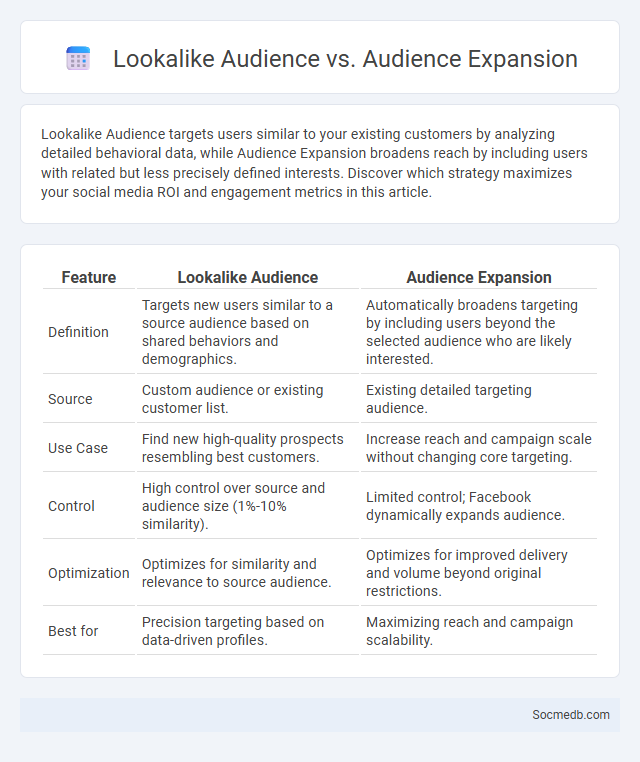
Photo illustration: Lookalike Audience vs Audience Expansion
Lookalike Audience targets users similar to your existing customers by analyzing detailed behavioral data, while Audience Expansion broadens reach by including users with related but less precisely defined interests. Discover which strategy maximizes your social media ROI and engagement metrics in this article.
Table of Comparison
| Feature | Lookalike Audience | Audience Expansion |
|---|---|---|
| Definition | Targets new users similar to a source audience based on shared behaviors and demographics. | Automatically broadens targeting by including users beyond the selected audience who are likely interested. |
| Source | Custom audience or existing customer list. | Existing detailed targeting audience. |
| Use Case | Find new high-quality prospects resembling best customers. | Increase reach and campaign scale without changing core targeting. |
| Control | High control over source and audience size (1%-10% similarity). | Limited control; Facebook dynamically expands audience. |
| Optimization | Optimizes for similarity and relevance to source audience. | Optimizes for improved delivery and volume beyond original restrictions. |
| Best for | Precision targeting based on data-driven profiles. | Maximizing reach and campaign scalability. |
Introduction to Advanced Audience Targeting
Advanced audience targeting on social media leverages data analytics, user behavior, and demographic insights to precisely reach your ideal customers. By utilizing tools like lookalike audiences, retargeting pixels, and interest-based segmentation, you can enhance engagement and conversion rates. Your campaigns become more efficient, ensuring the right message connects with the right people at the right time.
What is a Lookalike Audience?
A Lookalike Audience is a targeted group on social media platforms that shares similar characteristics and behaviors with your existing customers or followers, enabling more effective ad campaigns. This tool uses advanced algorithms to analyze data such as demographics, interests, and online activity to identify new potential customers who are likely to engage with your brand. By leveraging Lookalike Audiences, you can expand your reach and optimize your advertising budget to attract relevant and high-quality leads.
Understanding Audience Expansion
Understanding audience expansion on social media requires analyzing user demographics, interests, and engagement patterns to tailor content that resonates broadly. Leveraging data analytics tools helps identify new market segments and optimize targeting strategies for maximum reach. Your ability to adapt messaging based on these insights drives sustained growth and meaningful connections.
Key Differences: Lookalike Audience vs Audience Expansion
Lookalike Audience targets users closely matching your existing customers based on detailed behavioral and demographic data, optimizing ad relevance and conversion potential. Audience Expansion broadens your reach by including users with similar but less defined characteristics, increasing overall exposure but potentially lowering precision. You should choose Lookalike Audience for highly targeted campaigns and Audience Expansion when seeking broader awareness across new market segments.
How Lookalike Audiences Work in Digital Marketing
Lookalike audiences in digital marketing use algorithms to analyze Your existing customer data and identify new users with similar behaviors, interests, and demographics. By leveraging this data-driven approach, these audiences help optimize ad targeting and improve campaign performance. Marketers increase conversion rates by focusing on individuals most likely to engage with their brand.
Pros and Cons of Lookalike Audiences
Lookalike Audiences on social media platforms allow you to target users who share similar characteristics with your existing customers, enhancing the precision of your marketing campaigns and potentially increasing conversion rates. However, reliance on Lookalike Audiences can limit reach by focusing too narrowly on profiles resembling your current base, which may cause missed opportunities in unexplored segments. Balancing Lookalike Audiences with broader targeting strategies ensures your campaigns maintain diversity and scalability for sustainable growth.
Benefits and Limitations of Audience Expansion
Audience expansion on social media increases your brand's reach by targeting users similar to your existing followers, driving higher engagement and potential customer acquisition. It enables precise demographic and interest-based segmentation, optimizing ad spend and boosting overall campaign performance. Limitations include potential dilution of brand message and the risk of reaching less relevant audiences, which can reduce conversion rates and ROI.
Choosing the Right Strategy for Your Campaign
Selecting the right social media strategy for your campaign involves identifying target audience demographics, analyzing platform-specific engagement trends, and setting clear, measurable goals. Incorporating data-driven insights from tools like Facebook Analytics and Instagram Insights enhances content relevance and boosts conversion rates. Tailoring messaging to align with consumer behavior on each platform maximizes reach and ROI for marketing efforts.
Best Practices for Effective Audience Targeting
Effective audience targeting on social media requires detailed audience segmentation based on demographics, interests, and online behavior to tailor content that resonates deeply. Utilizing platform-specific analytics tools enables continuous refinement of targeting strategies by tracking engagement metrics and conversion rates. Employing lookalike audiences and retargeting campaigns enhances reach and brand relevancy, driving higher ROI through personalized ad placements.
Conclusion: Maximizing ROI with Audience Strategies
Maximizing ROI with audience strategies in social media requires precise targeting based on detailed demographic and behavioral data analytics. Your campaigns must leverage segmentation and personalized content to increase engagement rates and conversion metrics effectively. Consistent optimization using performance insights ensures sustained growth and higher return on investment.
 socmedb.com
socmedb.com